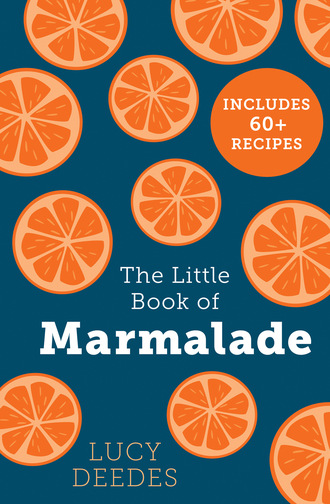
Полная версия
The Little Book of Marmalade
Spoon the mixture into the cake tin, being careful not to dislodge the orange slices. Bake for 30–45 minutes, until a skewer inserted into the middle comes out clean, then remove from the oven and allow to cool in its tin for 15 minutes.
Meanwhile, to make the drizzle, mix the remaining orange juice with the sugar and water in a small pan. Warm over a medium heat, stirring as the liquid turns into a syrup.
Turn the cake out of its tin and onto a plate, prick holes on the top with a skewer, and pour over the syrup. Leave for a few minutes for the syrup to sink in. Serve warm as a pudding, with cream or ice cream. Once cold, eat as cake!
CHOCOLATE AND MARMALADE TART
Serves 10
For the pastry
250g plain flour, plus extra for dusting
140g cold butter, diced
80g caster sugar
1 egg yolk, beaten
For the filling
3 heaped tbsp marmalade
85g butter
1 tsp orange extract
250g dark chocolate (70% cocoa solids), broken into small pieces
400ml double cream
To decorate (optional)
1 tbsp candied Seville orange peel (see here), chopped, or 1 tbsp hazelnuts, almonds or walnuts, chopped
To make the pastry, put the flour and butter into a food processor and process to a crumby texture. Add the sugar and egg yolk and whizz briefly until the dough balls up. Wrap the pastry loosely in cling film and chill for at least 30 minutes.
Heat the oven to 180°C/160°C fan/Gas 4 and place a baking sheet near the top of the oven.
Roll out the pastry dough on a lightly floured surface to 3–4mm thick (about the thickness of a pound coin). Use to line a 24cm fluted, loose-bottomed tart tin, pushing the pastry well into the corners. Prick the bottom gently with a fork and leave the pastry a little higher at the edges, to trim later. Line the inside of the pastry case with baking parchment and fill with baking beans or rice, then ideally chill for 10 minutes.
Bake the pastry case on the baking sheet for 15 minutes, then gently lift out the parchment and beans and cook for a further 5 minutes until pale brown; leave to cool. Separate out the marmalade peel from the syrup and chop it, then scatter it across the base of the cooled pastry case.
Melt the butter in a pan over a gentle heat, then add the chocolate, marmalade syrup and orange extract, and stir until melted and smooth. Heat the cream in a separate pan until almost boiling (do not bring to the boil as the mixture will split), then stir it into the chocolate mixture and keep stirring until smooth.
If needed, trim the top of the pastry case. Pour the chocolate filling into the pastry case and leave to cool and set completely. If you like, decorate with pieces of chopped candied orange or chopped nuts. Cut with a warm knife and serve with single cream.
CHILDHOOD MEMORIES
The Sixties were not extravagant times, food-wise. On Christmas eve we might glance in our fridge and see nothing in there, except a turkey and possibly a ham, that would not have been there at any other time of year. It was the tradition and the quantity that mattered: having the same as we had last year and plenty of it.
My mother had green and organic leanings long before it was fashionable. When she bought a box of tangerines at Christmas, the soft blue tissue paper in which they were wrapped was carefully folded and placed in the downstairs cloakroom.

SEVILLE ORANGE MARMALADE
If I am making this out of Seville orange season using frozen and defrosted oranges, then I add another lemon or two and perhaps a sweet orange to boost the pectin quantity. The ratio of water to fruit I use is 2.3:1 – 2.3 litres of cold water to 1 kg whole fruit. I have tinkered with sugar quantities over the years and my usual formula is now pulp to sugar: 4:3 (roughly translating as raw fruit to sugar: 3:4).
Soaking the chopped peel overnight is not essential if you are short of time, but it softens it, reducing the cooking time, and extracts the maximum possible pectin for a good set.
Makes 5–6 x 450g jars
1kg Seville oranges
250g lemons (2–3 lemons), plus the juice of 2 extra
2.8 litres water
1.7kg granulated or preserving sugar
For most citrus fruit except Seville oranges, I quarter them and then cut the entire fruit into fine slices. Seville oranges are too full of pips for this, so halve and juice them, adding the juice to the pan and any membranes to the muslin. Cut the halved shells in half again and, if the white pith is very thick, shave some of it away by flattening out the piece of peel and running a knife along it – much as you would skin a fish fillet. Don’t cut it all away; pith is vital to achieve a set and give that unique bitter taste to the marmalade. Add this pith to the muslin bag.
Cut the lemon quarters and orange peels into shreds about 2–4mm wide and add to the preserving pan with the water. Knot the muslin cloth and push it under the fruit and water. Ideally, leave to soak overnight.
The next day, bring the fruit and water to the boil and allow it to simmer gently for about 2 hours, stirring occasionally, pushing the bag under the water occasionally, until you can easily squash the peel with a wooden spoon. The water and fruit should be evenly mixed, like soup; if there is a clear band of water at the top then simmer it down some more. Remove from the heat, cover, and ideally leave it for another 24 hours.
Remove the muslin bag and place it in a sieve over a bowl to drain, squashing it gently to remove as much liquid as possible. Measure the volume of pulp from the pan (your pan may have measurements marked up the insides) and add sugar to a ratio of 4:3, so to each 100ml of pulp add 75g sugar. Add the lemon juice and the strained juice from the muslin to the pan.
Stir over a low heat until every grain of sugar has melted and you have a smooth, warm syrup. Turn the heat up high and switch on your oven to 150°C/130°C fan/Gas 2. Once the marmalade is boiling, it will take at least 20 minutes to reach a set. Put a baking tray of clean jars, right way up, in the oven for 15 minutes to sterilise.
Stir the marmalade occasionally, watching the way the drips fall off the spoon, and when instead of dripping cleanly from the spoon, the drops join together and hang in strings, you are nearly there. Once the temperature reaches 105°C, take the pan off the heat and let it cool and settle for 15–20 minutes (or the peel may rise to the top of the jar when you pot it up). If you don’t have a thermometer, use the wrinkle test (see here). Place your clean lids in the oven for 5 minutes.
Use the sterilising and sealing methods (see here). Screw the lids on loosely and return the full jars to the oven for 5 minutes, then use a tea towel to tighten the lids. Put them in a cool place, undisturbed, to cool before labelling.
Конец ознакомительного фрагмента.
Текст предоставлен ООО «ЛитРес».
Прочитайте эту книгу целиком, купив полную легальную версию на ЛитРес.
Безопасно оплатить книгу можно банковской картой Visa, MasterCard, Maestro, со счета мобильного телефона, с платежного терминала, в салоне МТС или Связной, через PayPal, WebMoney, Яндекс.Деньги, QIWI Кошелек, бонусными картами или другим удобным Вам способом.



